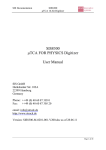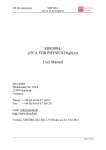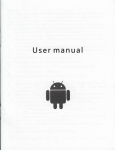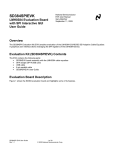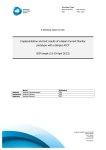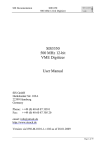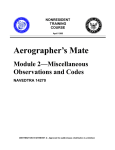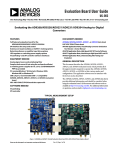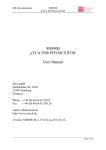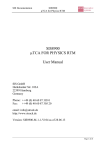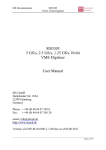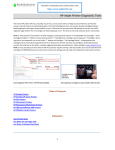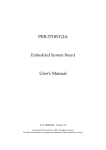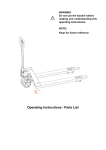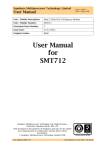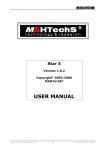Download SIS8300 µTCA FOR PHYSICS Digitizer User Manual
Transcript
SIS Documentation SIS8300 µTCA 16-bit Digitizer SIS8300 µTCA FOR PHYSICS Digitizer User Manual SIS GmbH Harksheider Str. 102A 22399 Hamburg Germany Phone: ++49 (0) 40 60 87 305 0 Fax: ++49 (0) 40 60 87 305 20 email: [email protected] http://www.struck.de Version: SIS8300-M-1402-1-V105.doc as of 17.10.2013 Page 1 of 67 SIS Documentation SIS8300 uTCA for Physics Digitizer Revision Table: Revision 1.00 Date 02.01.2012 1.01 1.02 1.03 13.01.2012 16.03.2012 28.09.2012 1.04 19.12.2012 1.05 17.10.2013 Page 2 of 67 Modification Based on SIS8300-M-1102-2-V211 Firmware: V1400 - add „Firmware Option register“ - add Memory Histogramming Feature - add Harlink Connector Output Test Mode - add SIS8900 RTM LVDS Test I/O Control register Added DMA register description, fixed reset register descr. Fix of broken reference FW: v1401 - add IRQ register description - add DAQ done IRQ - add DAQ done DMA start signal chain - add RAM FIFO debug register FW: v1402 - fixed MLVDS Bit7 Trigger enable bit - added Register 0x205 bit0 for byte swapped sample readout Fixed Sample Length Register description Added Firmware upgrade description SIS Documentation SIS8300 µTCA 16-bit Digitizer - Table of contents 1 2 3 4 5 6 7 Table of contents....................................................................................................................................... 3 Introduction .............................................................................................................................................. 5 1.1 Related documents............................................................................................................................. 5 Design ...................................................................................................................................................... 6 2.1 Functionality ..................................................................................................................................... 6 2.2 Block Diagram .................................................................................................................................. 6 2.3 Platform Management........................................................................................................................ 7 2.4 Clock Distribution ............................................................................................................................. 8 Jumper/Connector Pin Assignments........................................................................................................... 9 3.1 CON100 JTAG.................................................................................................................................. 9 3.2 J604 Watchdog Reset......................................................................................................................... 9 3.3 J32 AVR JTAG ................................................................................................................................. 9 LEDs ...................................................................................................................................................... 10 4.1 AMC LEDs ..................................................................................................................................... 10 4.2 Front Panel LEDs ............................................................................................................................ 10 4.3 SMD LEDs...................................................................................................................................... 10 Front panel.............................................................................................................................................. 11 5.1 Harlink LVDS In-/Outputs............................................................................................................... 12 5.2 SMA Clock Input ........................................................................................................................... 12 5.3 SFP Card Cage ................................................................................................................................ 12 Board Layout .......................................................................................................................................... 13 Firmware Description.............................................................................................................................. 14 7.1 ADC Sample Logic ......................................................................................................................... 14 7.2 Memory Interface ............................................................................................................................ 16 7.2.1 Memory Write Interface ........................................................................................................... 17 7.2.2 Memory Histogram Interface.................................................................................................... 18 7.3 Memory buffer ................................................................................................................................ 19 7.4 Address Map ................................................................................................................................... 20 7.5 Register description ......................................................................................................................... 22 7.5.1 Module Id. and Firmware Revision register .............................................................................. 22 7.5.2 Serial Number register.............................................................................................................. 22 7.5.3 XILINX JTAG register ............................................................................................................ 23 7.5.4 XILINX Virtex5 Error Detection register.................................................................................. 23 7.5.5 User Control/Status register..................................................................................................... 24 7.5.6 Firmware Options register ........................................................................................................ 25 7.5.7 ADC Acquisition Control/Status register ................................................................................. 26 7.5.8 ADC Sample Control register................................................................................................... 27 7.5.9 MLVDS Input/Output Control register ..................................................................................... 28 7.5.10 Harlink Connector Input/Output Control register ...................................................................... 29 7.5.11 Clock Distribution Multiplexer control register......................................................................... 30 7.5.12 Clock Distribution AD9510 Serial Interface (SPI) interface register (0x41, read/write).............. 32 7.5.13 Clock Multiplier IC SI5326 SPI interface register .................................................................... 34 7.5.14 DAC Control register ............................................................................................................... 35 7.5.15 DAC Data register.................................................................................................................... 35 7.5.16 ADC Serial Interface (SPI) interface register ............................................................................ 36 7.5.17 ADC Input Tap delay registers (0x49) ...................................................................................... 37 7.5.18 Virtex 5 System Monitor registers ............................................................................................ 37 7.5.19 Trigger registers....................................................................................................................... 38 7.5.20 Memory Sample Start Address / Actual Sample Address registers............................................. 41 7.5.21 Sample Length register............................................................................................................. 42 7.5.22 Ringbuffer Delay register ......................................................................................................... 42 7.5.23 Test Histogram Pattern-Memory Address register..................................................................... 43 7.5.24 Test Histogram Pattern-Memory Data Write register................................................................. 43 7.5.25 Test Histogram Control register................................................................................................ 44 7.5.26 SIS8900 RTM LVDS Test Input/Output Control register .......................................................... 45 7.5.27 Read DMA System Destination address (lower 32bits) ............................................................. 46 Page 3 of 67 SIS Documentation SIS8300 uTCA for Physics Digitizer 7.5.28 Read DMA System Destination address (upper 32bits) ............................................................. 46 7.5.29 Read DMA Card Memory Source address ................................................................................ 46 7.5.30 Read DMA Transfer length ...................................................................................................... 47 7.5.31 Read DMA Control.................................................................................................................. 47 7.5.32 Readout DMA Sample byte swap ............................................................................................. 47 7.5.33 Write DMA System Source address (lower 32bits) ................................................................... 48 7.5.34 Write DMA System Source address (upper 32bits) ................................................................... 48 7.5.35 Write DMA Card Memory Destination address......................................................................... 48 7.5.36 Write DMA Transfer length ..................................................................................................... 49 7.5.37 Write DMA Control ................................................................................................................. 49 7.5.38 DAQ Done DMA Chain Control .............................................................................................. 50 7.5.39 IRQ Enable.............................................................................................................................. 50 7.5.40 IRQ Status ............................................................................................................................... 51 7.5.41 IRQ Clear ................................................................................................................................ 51 7.5.42 IRQ Refresh............................................................................................................................. 51 7.5.43 RAM FIFO debug register........................................................................................................ 52 7.6 External register interface ................................................................................................................ 53 7.7 User Blockram DMA Interface ........................................................................................................ 55 7.8 User Interrupt Interface.................................................................................................................... 55 8 RTM management................................................................................................................................... 56 9 Firmware upgrade ................................................................................................................................... 57 9.1 Create programming file .................................................................................................................. 57 9.2 Create PROM file............................................................................................................................ 58 9.3 Program FPGA................................................................................................................................ 59 10 Appendix ............................................................................................................................................ 61 10.1 Power Consumption......................................................................................................................... 61 10.2 Ordering options.............................................................................................................................. 61 10.3 RTM/Zone 3 connectors J75 and J76 ............................................................................................... 62 10.3.1 J75 connector pin assignments.................................................................................................. 62 10.3.2 J76 connector pin assignments.................................................................................................. 63 10.3.3 Note on AC/DC input stage selection........................................................................................ 63 10.4 RTM connector schematics.............................................................................................................. 65 11 Index................................................................................................................................................... 66 Page 4 of 67 SIS Documentation 1 SIS8300 µTCA 16-bit Digitizer Introduction The SIS8300 is a ten 10 channel 125 MS/s digitizer with 16-bit resolution according to the for Physics draft standard. uTCA SIS8300 with SFPs installed As we are aware, that no manual is perfect, we appreciate your feedback and will incorporate proposed changes and corrections as quickly as possible. The most recent version of this manual can be obtained by email from [email protected], the revision dates are online under http://www.struck.de/manuals.html . Note 1: It is PICMG‘s policy to prohibit claims of compliance with respect to a specification under development. Any such claims must be understood as applying to a draft, which is subject to change Note 2: The SIS8300 is developed in co-operation with DESY under ZIM grant 2460101MS9 (ZIM: Zentrales Innovationsprogramm Mittelstand) 1.1 Related documents A list of available firmware designs can be retrieved from http://www.struck.de/sis8300firm.html Page 5 of 67 Struck Documentation 2 SIS8300 uTCA for Physics Digitizer Design The central building block of the SIS8300 card is a Xilinx Virtex 5 FPGA. It holds the 4 lane PCI Express interface and is in control of all active components. 2.1 Functionality The key properties of the SIS8300 card are listed below. AMC .4 µTCA for Physics Board 4 Lane PCI Express Interface Dual SFP Card Cage for optional Multi Gigabit Link Xilinx Virtex 5 FPGA DDR2 Memory Interface 4 x 1 GBit default DDR2 memory (4 x 2 GBit option) Atmega128 IPMI External Clock and Trigger Inputs Frontpanel digital I/O (4in/4 out) on Harlink Connectors RTM ADC Analog Inputs, I2C-Bus 10 ADC Channels 125MS/s, 16-Bit 2 DAC Channels 250MS/s, 16-Bit Clock distribution with phase shifting 4 M-LVDS µTCA Ports 2 µTCA Clocks 2.2 Block Diagram A simplified block diagram of the SIS8300 is shown below. Page 6 of 67 Struck Documentation 2.3 SIS8300 uTCA for Physics Digitizer Platform Management The management code of the SIS8300 is implemented in an Atmel Atmega1281-16MU microcontroller and can be upgrade in field over connector J32 (see section 3.3). Page 7 of 67 Struck Documentation SIS8300 uTCA for Physics Digitizer 2.4 Clock Distribution The clock distribution scheme of the SIS8300 is illustrated below. #2 2 0 MUX C 1 MUX E 1 3 3 2 0 ADCLK925 ADCLK925 MUX A MUX B 1 2 0 3 1 2 Ch9 T ADC ADC T FPGA CLK05 ADC ADC T T #1 3 ADC ADC µRTM SI5324 AD9510 0 1 FPGA CLK69 AD9510 MUX D 3 2 ADC ADC ADC ADC Ch1 Ch0 0 RTM_CLK0 RTM_CLK2 CLK1 CLK2 Backplane ADCLK925 ADCLK946 ADCLK925 ADCLK925 ADCLK946 EXTCLKB HARLINK ADCLK925 Quartz EXTCLKA SMA RTM_CLK1 Page 8 of 67 Struck Documentation SIS8300 uTCA for Physics Digitizer 3 Jumper/Connector Pin Assignments The following subsections describe the pin assignments of jumpers and connectors. 3.1 CON100 JTAG The SIS8300’s on board logic can load its firmware from a serial PROM, via the JTAG port on connector CON100, PCI Express or via the MMC. Hardware like the XILINX HW-USB-JTAG in connection with the appropriate software will be required for in field JTAG firmware upgrades. CON100 is a 2mm (i.e. metric) 14 pin header that allows you to reprogram the firmware of the SIS8300 board with a JTAG programmer. The pin out is shown in the schematic below. It is compatible with the cable that comes with the XILINX HW-USB-II-G-JTAG platform cable. CON100 can be found at the right bottom side of the board. Note 1: The board has to be powered for reprogramming over JTAG Note 2: The FPGA uses 8-bit parallel mode to load the firmware from the serial PROM. Make sure to check the 'Parallel Load' box in Impact when specifying the programming properties for the PROM. 3.2 J604 Watchdog Reset J604 can be found next to the left upper edge of U500 (largest chip on the card). With J604 closed the boards watchdog reset is connected to the reset logic. J604 should be opened for JTAG firmware programming. 3.3 J32 AVR JTAG This 10-pin header is used to connect to the JTAG of the Atmel Atmega128 microcontroller providing the IPMI/MCH functionality of the SIS8300. Page 9 of 67 Struck Documentation SIS8300 uTCA for Physics Digitizer 4 LEDs 4.1 AMC LEDs The AMC LEDs are implemented according to the standard. 4.2 Front Panel LEDs The SIS8300 in Gigalink stuffing option has 4 green front panel LEDs. LED name A U L1 L2 Function in Gigalink design PCI Express Access User LED PCIe Link up ADC Sampling active 4.3 SMD LEDs A number of surface mount red LEDs are on the SIS8300 to visualize part of the board status. LED designator D20A LED comment S1 D20B S2 D20C D20D D20E D20F D20G D20H D21D D105A D105B D110A D110B S3 S4 S5 S6 S7 S8 READY TX FAULT 1 RX LOS 1 TX FAULT 2 RX LOS 2 Page 10 of 67 Function Firmware dependent (Optical Link 1 up in 0x1102) Firmware dependent (Optical Link 2 up in 0x1102) Firmware dependent Firmware dependent Firmware dependent Firmware dependent Firmware dependent Firmware dependent FPGA ready Link 1 transmitter fault Link 1 receiver loss of signal Link 2 transmitter fault Link 2 receiver loss of signal Struck Documentation SIS8300 uTCA for Physics Digitizer 5 Front panel The SIS8300 is a µTCA for Physics board. A sketch of the front panel is shown below. Page 11 of 67 Struck Documentation SIS8300 uTCA for Physics Digitizer 5.1 Harlink LVDS In-/Outputs The Harlink LVDS Output and Input connectors have 5 signals each. The Clock signal to the left hand side is marked with C and the other 4 signals are labelled with 1-4. Top Bottom Clock P N 1 P N 2 P N 3 P N 4 P N 5.2 SMA Clock Input The front panel SMA clock input is designed to accept a maximum peak to peak signal level of 3V into 50 Ohms. The clock input signal is coupled to the internal logic via a capacitor. The schematic of the input stage is shown below. 5.3 SFP Card Cage The dual card cage can host two SFP link media. They can be enabled in the sis8300top.vhd VHDL code as shown below (and are active in the 0x1102 firmware design e.g.): DUAL_OPTICAL_INTERFACE_EN : integer := 1 ; -- Communication is handled through registers 0x14 to 0x17 (refer to the VHDL code) Page 12 of 67 Struck Documentation SIS8300 uTCA for Physics Digitizer 6 Board Layout A print of the silk screen of the component side is shown below. Connector types The used connectors are listed in the table below. Designator CON100 CON200 CON301 CON302 CAGE105 J10 J32 J75 J76 J77 J209 J205 J604 Function JTAG Clock In DAC 1 Out DAC 2 Out SFP Cage, 2 Ports AdvancedMC JTAG Atmega RTM RTM RTM Keying Trigger & Clock Out Trigger & Clock In Watchdog Manufacturer Molex JYEBAO JYEBAO JYEBAO TYCO HARTING SAMTEC ERNI ERNI TYCO HARTING HARTING SAMTEC Part Number 87831-1420 SMA8400A1-9000 SMA8400A1-9000 SMA8400A1-9000 1761014-1 16211701301000 HTSW-105-26-G-D ERmetZD-10x3P-FEM ERmetZD-10x3P-FEM (*) 27 21 121 8000 27 21 121 8000 HTSW-102-26-G-S Note (*): The used Key may depend on the hardware configuration of the SIS8300 Page 13 of 67 Struck Documentation SIS8300 uTCA for Physics Digitizer 7 Firmware Description 7.1 ADC Sample Logic The block diagram shows the ADC data handling. Each ADC channel has its own Memory Address Control Logic. Page 14 of 67 Struck Documentation SIS8300 uTCA for Physics Digitizer The block diagram shows the ADC data handling. Two ADC channels share the same Memory Address Control Logic. The “Single-Channel Copy-To-Memory” Logic needs more FPGA resources ( +2500 Registers, +700 Slices, +10 BlockRams) than the “Dual-Channel Copy-To-Memory” Logic. Page 15 of 67 Struck Documentation SIS8300 uTCA for Physics Digitizer 7.2 Memory Interface The “sis_ddr2_interface_with_histogramming” provides the user logic with the possibility to write to the Memory and to increment (histogram) the content of 32-bit memory values. sis_ddr2_interface DDR2 Memory Read Interface Data Fifo 512 x 128 PCIe DMA Interface Address Fifo 512 x 32 Write Interface sis_write_addr_fifo_wr_en sis_write_64bit_addr_fifo_din protocol Address Fifo 512 x 32 sis_write_addr_fifo_wr_count 512 MByte (64M x 64 bit) or addr 1 GByte (128M x 64 bit) sis_write_data_fifo_wr_en sis_write_data_fifo_din data Data Fifo 1023 x 128 sis_write_data_fifo_wr_count Histogram Interface sis_write_histo_addr_fifo_wr_en sis_write_histo_32bit_addr_fifo_din Address Fifo 512 x 32 sis_write_histo_addr_fifo_wr_count User Interface block diagram for Memory read, write and histogram operations. Page 16 of 67 Struck Documentation SIS8300 uTCA for Physics Digitizer 7.2.1 Memory Write Interface The Write Interface consists of the following signals: sis_write_fifo_wr_clk : in std_logic; -- data: write fifo sis_write_data_fifo_wr_en : in std_logic; sis_write_data_fifo_din : in std_logic_vector(127 downto 0); sis_write_data_fifo_wr_count : out std_logic_vector(9 downto 0); -- address: write fifo sis_write_addr_fifo_wr_en : in std_logic; sis_write_64bit_addr_fifo_din : in std_logic_vector(31 downto 0); sis_write_addr_fifo_wr_count : out std_logic_vector(9 downto 0) ; A write cycle to the memory consists of one write command to the Address Fifo and two write commands to the Data Fifo. One write command to the Address FIFO: a valid “sis_write_addr_fifo_wr_en” signal over one clock period (sis_write_fifo_wr_clk) along with “sis_write_64bit_addr_fifo_din”. Two write commands to the Data FIFO: a valid “sis_write_data_fifo_wr_en” signal over two clock periods (sis_write_fifo_wr_clk) along with “sis_write_data_fifo_din”. When issuing a write command to the Address Fifo, the second write command to the Data Fifo must be issued no more than one clock cycle later. It is only allowed to write to the Address-FIFO, if “sis_write_addr_fifo_wr_count” is lower than X”1FF” (not full). It is only allowed to write to the Data-FIFO, if “sis_write_data_fifo_wr_count” is lower than X”3FE” (not full). The Memory Controller writes with one “write cycle” 256 bits (4 x 64 bits) to the Memory. Therefore the lower 2 address bits of the written 64-bit address must be 0 and the “next address” will be incremented by 4. Page 17 of 67 Struck Documentation SIS8300 uTCA for Physics Digitizer 7.2.2 Memory Histogram Interface The Histogram Interface consists of the following signals: -- Histogramming -- address: write fifo sis_write_histo_addr_fifo_clr: in std_logic; sis_write_histo_addr_fifo_wr_clk: in std_logic; sis_write_histo_addr_fifo_wr_en: in std_logic; sis_write_histo_32bit_addr_fifo_din: in std_logic_vector(31 downto 0); sis_write_histo_addr_fifo_wr_count: out std_logic_vector(9 downto 0) ; A write command to the Histogram Address Fifo will increment by one the content of the 32bit Memory value addressed with the written 32-bit Memory Address. It is only allowed to write to the Histo-Address-FIFO, if “sis_write_histo_addr_fifo_wr_count” is lower than X”1FF” (not full). The histogramming memory controller supports an update rate of 5MHz (20 MHz within one 2K memory page amid differing three lowest order bits). Page 18 of 67 Struck Documentation SIS8300 uTCA for Physics Digitizer 7.3 Memory buffer The structure of the memory buffer with 512 MByte (i.e. 4 x 1 GBit memory chips) is illustrated below. 512 MByte : 4 x 64M x 16bit = 256M x 16bit = 32M x 128bit = 16M x 256bit Memory 256-bit Block Addresses 0 x 00 0000 Memory 64-bit Addresses Memory 32-bit Addresses Memory 16-bit Addresses (4 x 256-bit Address) (8 x 256-bit Address) (16 x 256-bit Address) (32 x 256-bit Address) 0 x 000 0000 0 x 000 0000 0 x 0000 0000 0 x 0000 0000 0 x 0000 0001 0 x 0000 0001 .. .. 0 x 0000 000E 0 x 0000 001E 0 x 0000 000F 0 x 0000 001F 0 x 0800 0006 0 x 1000 000E 0 x 0800 0007 0 x 1000 000F 0 x 00 0001 0 x 000 0001 0 x 00 0002 0 x 000 0002 .. 0 x 7F FFFF 0 x 80 0000 0 x 80 0001 0 x 80 0002 0 x 000 0003 .. 0 x 200 0000 0 x FF FFFF .. 0 x 000 0006 0 x 000 0007 .. 0 x 200 0001 0 x 400 0002 0 x 200 0002 0 x 400 0003 0 x 200 0003 .. .. 0 x 000 0001 0 x 3FF FFFC 0 x 3FF FFFD .. 0 x 7FF FFF8 0 x 7FF FFF9 .. 0 x 3FF FFFE 0 x 7FF FFFE 0 x 3FF FFFF 0 x 7FF FFFF .. Memory 8-bit (byte) Addresses .. .. .. 0 x 0FFF FFF0 0 x 1FFF FFE0 0 x 0FFF FFF1 0 x 1FFF FFE1 .. .. 0 x 0FFF FFFE 0 x 1FFF FFFE 0 x 0FFF FFFF 0 x 1FFF FFFF The structure of the memory buffer with 1 GByte (i.e. 4 x 2 GBit memory chips) is illustrated below. Page 19 of 67 Struck Documentation SIS8300 uTCA for Physics Digitizer 7.4 Address Map Following 32-bit addresses are implemented Offset 0x00 0x01 0x02 0x03 Access R R R/W R 0x04 0x05 R/W R User Control/Status register (JK) Firmware Options register 0x10 0x11 0x12 0x13 R/W R/W R/W R/W ADC Acquisition Control/Status register ADC Sample Control register MLVDS Input/Output Control register Harlink Connector Input/Output Control register 0x14 0x15 0x16 0x17 R/W R/W R/W R/W Link 1 data FIFO (refer to VHDL code) Link 1 set control (refer to VHDL code Link 2 data FIFO (refer to VHDL code Link 2 set control (refer to VHDL code 0x40 0x41 0x42 R/W R/W R/W Clock Distribution Multiplexer control register Clock Distribution IC AD9510 SPI interface register Clock Multiplier IC SI5326 SPI interface register 0x44 0x45 0x46 R/W R/W R/W reserved DAC Control register DAC Data register 0x48 0x49 R/W R/W ADC SPI Interface register ADC Input Tap delay register 0x90 0x91 0x92 R/W R/W R/W VIRTEX5_SYSTEM_MONITOR_DATA register VIRTEX5_SYSTEM_MONITOR_ADDR register VIRTEX5_SYSTEM_MONITOR_CTRL register 0xFF 0x100 0x101 .. .. 0x109 W R/W R/W Bit 0 = 1: Master Reset (reset all registers) ADC ch1 Trigger Setup register ADC ch2 Trigger Setup register .. .. ADC ch10 Trigger Setup register 0x110 0x111 .. 0x119 R/W R/W 0x120 Page 20 of 67 R/W Function Module Identifier/Firmware Version register Serial number register XILINX JTAG register XILINX Virtex5 configuration memory Error Detection register R/W ADC ch1 Trigger Threshold register ADC ch2 Trigger Threshold register .. ADC ch10 Trigger Threshold register R/W ADC ch1 Memory Sample Start Address / Actual Address register Struck Documentation SIS8300 uTCA for Physics Digitizer 0x121 .. 0x129 R/W R/W ADC ch2 Memory Sample Start Address / Actual Address register .. ADC ch10 Memory Sample Start Address / Actual Address register 0x12A 0x12B R/W R/W ADC chx Sample Length register ADC chx Ringbuffer Delay register (0 to 2046) 0x12C 0x12D 0x12E 0x12F R/W R/W R/W R/W Test Histogram Pattern-Memory Address register Test Histogram Pattern-Memory Data Write register Test Histogram Control register SIS8900 RTM LVDS Test Input/Output Control register 0x200 0x201 0x202 0x203 0x204 0x205 R/W R/W R/W R/W R/W R/W DMA_READ_DST_ADR_LO32 DMA_READ_DST_ADR_HI32 DMA_READ_SRC_ADR_LO32 DMA_READ_LEN DMA_READ_CTRL DMA Readout Sample byte swap control 0x210 0x211 0x212 0x213 0x214 0x216 0x220 0x221 0x222 0x223 0x230 0x231 0x400 R/W R/W R/W R/W R/W R/W R/W R W KA R/W R/W R/W DMA_WRITE_SRC_ADR_LO32 DMA_WRITE_SRC_ADR_HI32 DMA_WRITE_DST_ADR_LO32 DMA_WRITE_LEN DMA_WRITE_CTRL DAQ Auto DMA Chain Control IRQ Enable IRQ Status IRQ Clear IRQ Refresh MEMORY test Mode register RAM FIFO debug register Mapped out of register bank to top level. May be used for user defined register implementation. See Section 7.6. ... ... 0x4FF R/W Page 21 of 67 Struck Documentation SIS8300 uTCA for Physics Digitizer 7.5 Register description 7.5.1 Module Id. and Firmware Revision register #define SIS8300_IDENTIFIER_VERSION_REG 0x00 This register holds the module identifier (SIS8300) and the firmware version and revision. BIT access Name 31-16 RO Function Module Identifier 0x8300 Firmware Version 1..255 Firmware Revision 1..255 FFFF0000 15-8 RO 0000FF00 7-0 RO 000000FF Example: The initial version of the SIS8300 reads 0x83001400 7.5.2 Serial Number register #define SIS8300_SERIAL_NUMBER_REG 0x01 This register holds the Serial Number of the module. BIT access Name 31-16 RO Function reserved FFFF0000 15-0 RO 0000FFFF Page 22 of 67 Serial Number 1..65535 Struck Documentation SIS8300 uTCA for Physics Digitizer 7.5.3 XILINX JTAG register #define SIS8300_XILINX_JTAG_REG 0x02 This register is used in the firmware upgrade process over PCIe only. A TCK is generated upon a write cycle to this register. Bit 31 30 ... 4 3 2 1 0 write Function none ... ... none none none TMS TDI read Function TDO 1 x Shifted TDO 30 x Shifted TDO The read register function operates as a shift register for TDO. The content of the read register is shifted to the right by one bit with every positive edge of TCK and the status of TDO is transferred to Bit 30. Bit 31 reflects the current value of TDO during a read access. 7.5.4 XILINX Virtex5 Error Detection register #define SIS8300_XILINX_ECC_REG 0x03 XILINX Virtex5 configuration memory error detection register. Bit 31 30 ... 16 15 14 13 12 11 .. 1 0 read Function 0 0 0 Frame ECC output indicating a valid SYNDROME value 0 CRC Error ECC Error SYNDROME: Status bit 11 SYNDROME: Status bit 1 SYNDROME: Status bit 0 Page 23 of 67 Struck Documentation SIS8300 uTCA for Physics Digitizer 7.5.5 User Control/Status register #define SIS8300_USER_CONTROL_STATUS_REG 0x04 The control register is implemented as a selective J/K register, a specific function is enabled by writing a 1 into the set/enable bit, the function is disabled by writing a 1 into the clear/disable bit (which location is 16-bit higher in the register). An undefined toggle status will result from setting both the enable and disable bits for a specific function at the same time. The only function at this point in time is user LED on/off. On read access the same register represents the status register. Bit 31 30 29 28 27 26 25 24 23 22 21 20 19 18 17 16 15 14 13 12 11 10 9 8 7 6 5 4 3 2 1 0 write Function Clear reserved 15 (*) Clear reserved 14 (*) Clear reserved 13 (*) Clear reserved 12 (*) Clear reserved 11 (*) Clear reserved 10 (*) Clear reserved 9 (*) Clear reserved 8 (*) Clear reserved 7 (*) Clear reserved 6 (*) Clear reserved 5 (*) Clear reserved 4 (*) Clear reserved 3 (*) Clear reserved 2 (*) Switch off LED test Switch off user LED (*) Set reserved 15 Set reserved 14 Set reserved 13 Set reserved 12 Set reserved 11 Set reserved 10 Set reserved 9 Set reserved 8 Set reserved 7 Set reserved 6 Set reserved 5 Set reserved 4 Set reserved 3 Set reserved 2 Switch on LED test Switch on user LED (*) denotes power up default setting Page 24 of 67 read Function 0 0 0 0 0 0 0 0 0 0 0 0 0 0 0 0 Status reserved 15 Status reserved 14 Status reserved 13 Status reserved 12 Status reserved 11 Status reserved 10 Status reserved 9 Status reserved 8 Status reserved 7 Status reserved 6 Status reserved 5 Status reserved 4 Status reserved 3 Status reserved 2 Status LED test Status User LED (1=LED on, 0=LED off) Struck Documentation SIS8300 uTCA for Physics Digitizer 7.5.6 Firmware Options register #define SIS8300_FIRMWARE_OPTIONS_REG 0x05 This register holds the information of the Xilinx firmware option features. Bit 31 30 ... 16 15 14 13 12 11 10 9 8 7 6 5 4 3 2 1 0 read Function reserved ... ... reserved reserved reserved reserved reserved reserved reserved reserved FPGA_SX_1GByte Memory reserved DUAL_OPTICAL_INTERFACE_EN DUAL_PORT14_15_INTERFACE_EN DUAL_PORT12_13_INTERFACE_EN none DUAL_CHANNEL_SAMPLING RINGBUFFER_DELAY_EN TRIGGER_BLOCK_EN FPGA_SX_1GByte Memory = 0 : Virtex 50LX50T and 512 MByte Memory FPGA_SX_1GByte Memory = 1 : Virtex 50SX50T and 1 GByte Memory Page 25 of 67 Struck Documentation SIS8300 uTCA for Physics Digitizer 7.5.7 ADC Acquisition Control/Status register #define SIS8300_ACQUISITION_CONTROL_STATUS_REG Bit 31 .. .. 8 7 6 5 4 3 2 1 0 write ‘1’ : Disable Sampling (Reset Sample Logic) ‘1’ : Arm Sampling (Start with next trigger) ‘1’ : Start Sampling immediately (Arm and Start/Trigger) The power up default value is 0x0 Page 26 of 67 0x10 read 0 0 0 0 Status: DDR2 Memory Init OK 0 Status: internal Sample Logic Buffer FIFO Not Empty Status: internal Sample Logic Busy 0 0 Status: Arm for trigger (Wait for trigger) Status: Sampling Busy Struck Documentation SIS8300 uTCA for Physics Digitizer 7.5.8 ADC Sample Control register #define SIS8300_SAMPLE_CONTROL_REG 0x11 ADC channels can be disabled from storing data to memory by setting the corresponding disable bit in this register. Bit 31 ... ... 12 11 10 9 8 7 6 5 4 3 2 1 0 write Enable external Trigger Enable internal Trigger Disable Sampling Ch10 Disable Sampling Ch9 Disable Sampling Ch3 Disable Sampling Ch2 Disable Sampling Ch1 The power up default value is 0x0 Page 27 of 67 Struck Documentation SIS8300 uTCA for Physics Digitizer 7.5.9 MLVDS Input/Output Control register #define SIS8300_MLVDS_IO_CONTROL_REG Bit 31 30 .. 25 24 23 22 ... 17 16 15 14 ... 9 8 7 6 ... 1 0 0x12 Write Enable LVDS Output Bit 7 Enable LVDS Output Bit 6 Read Enable LVDS Output Bit 7 Enable LVDS Output Bit 6 Enable LVDS Output Bit 1 Enable LVDS Output Bit 0 LVDS Output Bit 7 LVDS Output Bit 6 Enable LVDS Output Bit 1 Enable LVDS Output Bit 0 LVDS Output Bit 7 LVDS Output Bit 6 LVDS Output Bit 1 LVDS Output Bit 0 LVDS Input 7 External Trigger Enable LVDS Input 6 External Trigger Enable LVDS Output Bit 1 LVDS Output Bit 0 LVDS Input 7 External Trigger Enable LVDS Input 6 External Trigger Enable LVDS Input 1 External Trigger Enable LVDS Input 0 External Trigger Enable LVDS Input 7 External Trigger falling edge LVDS Input 6 External Trigger falling edge LVDS Input 1 External Trigger Enable LVDS Input 0 External Trigger Enable LVDS Input Bit 7 LVDS Input Bit 6 LVDS Input 1 External Trigger falling edge LVDS Input Bit 1 LVDS Input 0 External Trigger falling edge LVDS Input Bit 0 Note: external trigger in signals are synchronized with the FPGA CLK05 Page 28 of 67 Struck Documentation SIS8300 uTCA for Physics Digitizer 7.5.10 Harlink Connector Input/Output Control register #define SIS8300_HARLINK_IO_CONTROL_REG Bit 31 30 .. 21 20 19 18 17 16 15 14 13 12 11 10 9 8 7 6 5 4 3 2 1 0 0x13 Write No function No function Read 0 0 No function Harlink Test Output Enable Harlink Test Output 4 (*) Harlink Test Output 3 (*) Harlink Test Output 2 (*) Harlink Test Output 1 (*) Harlink Input 4 External Trigger falling edge Harlink Input 3 External Trigger falling edge Harlink Input 2 External Trigger falling edge Harlink Input 1 External Trigger falling edge Harlink Input 4 External Trigger Enable Harlink Input 3 External Trigger Enable Harlink Input 2 External Trigger Enable Harlink Input 1 External Trigger Enable No function No function No function No function No function No function No function No function 0 Harlink Test Output Enable Harlink Test Output 4 Harlink Test Output 3 Harlink Test Output 2 Harlink Test Output 1 Harlink Input 4 External Trigger falling edge Harlink Input 3 External Trigger falling edge Harlink Input 2 External Trigger falling edge Harlink Input 1 External Trigger falling edge Harlink Input 4 External Trigger Enable Harlink Input 3 External Trigger Enable Harlink Input 2 External Trigger Enable Harlink Input 1 External Trigger Enable 0 0 0 0 Harlink Input 4 Harlink Input 3 Harlink Input 2 Harlink Input 1 (*): only if “Harlink Test Output Enable” = 1 (**): only if “Harlink Test Output Enable” = 0 Harlink Connector Input(1) : external trigger In Harlink Connector Output(1) : adc chx (or) trigger out (**) Note: external trigger in signals are synchronized with the FPGA CLK05 Page 29 of 67 Struck Documentation SIS8300 uTCA for Physics Digitizer 7.5.11 Clock Distribution Multiplexer control register #define SIS8300_CLOCK_DISTRIBUTION_MUX_REG 0x40 The SIS8300 has 5 IDT ICS853S057 clock multiplexer chips, which are labelled A to E in the clock distribution schematic in section 2.4. The multiplexer control register holds the two select bits for the 5 multiplexer chips as shown in the table below. The assignment of the inputs to the resources (i.e. clock inputs) is listed in subsection 7.5.11.1. BIT access Name 31-12 R/W Function reserved no MUXE_SEL Multiplexer E select bits MUXD_SEL Multiplexer D select bits reserved no MUXC_SEL Multiplexer C select bits MUXB_SEL Multiplexer B select bits MUXA_SEL Multiplexer A select bits FFFFF000 11-10 R/W 00000C00 9-8 R/W 00000300 7-6 R/W 000000C0 5-4 R/W 00000030 3-2 R/W 0000000C 1-0 R/W 00000003 Page 30 of 67 Struck Documentation 7.5.11.1 SIS8300 uTCA for Physics Digitizer Multiplexer A Input Signals: U222 - Sel0 and Sel1 (MUX1A_SEL) = Multiplexer A select lines Sel1 0 0 1 1 Sel0 0 1 0 1 7.5.11.2 Selected Input - Net Name RTMCLK_0 TCLKB_0 TCLKA_0 OSC_CLK0 Clock source Description Clock 2 from µRTM card Clock 2 (Telecom Clock B) from AMC Connector (Backplane) Clock 1 (Telecom Clock A) from AMC Connector (Backplane) Onboard Clock chip (250MHz) Multiplexer B Input Signals: U223 - Sel0 and Sel1 (MUX1B_SEL) = Multiplexer B select lines Sel1 0 0 1 1 Sel0 0 1 0 1 7.5.11.3 Selected Input - Net Name RTMCLK_1 TCLKB_1 TCLKA_1 OSC_CLK1 Clock source Description Clock 2 from µRTM card Clock 2 (Telecom Clock B) from AMC Connector (Backplane) Clock 1 (Telecom Clock A) from AMC Connector (Backplane) Onboard Clock chip (250MHz) Multiplexer C Input Signals: U240 - Sel0 and Sel1 (MUXAB_SEL) = Multiplexer C select lines Sel1 0 0 1 1 Sel0 0 1 0 1 7.5.11.4 Selected Input - Net Name EXT_CLKB0 EXT_CLKA0 MUXA_CLK1 MUXB_CLK1 Clock source Description Clock from Harlink Connector “CI1-4 IN” (frontpanel) Clock from SMA Connector “CLK IN” (frontpanel) Multiplexer A Output Signal Multiplexer B Output Signal Multiplexer D Input Signals: U250 - Sel0 and Sel1 (MUX2A_SEL) = Multiplexer D select lines Sel1 0 0 1 1 Sel0 0 1 0 1 7.5.11.5 Selected Input - Net Name MUXA_CLK0 MUL_CLK1 EXT_CLKB1 EXT_CLKA1 Clock source Description Multiplexer A Output Signal Clock Multiplier (U242) Output 2 Signal Clock from Harlink Connector “CI1-4 IN” (frontpanel) Clock from SMA Connector “CLK IN” (frontpanel) Multiplexer E Input Signals: U251 - Sel0 and Sel1 (MUX2B_SEL) = Multiplexer E select lines Sel1 0 0 1 1 Sel0 0 1 0 1 Selected Input - Net Name MUXB_CLK0 MUL_CLK0 EXT_CLKB2 EXT_CLKA2 Clock source Description Multiplexer B Output Signal Clock Multiplier (U242) Output 1 Signal Clock from Harlink Connector “CI1-4 IN” (frontpanel) Clock from SMA Connector “CLK IN” (frontpanel) Page 31 of 67 Struck Documentation SIS8300 uTCA for Physics Digitizer 7.5.12 Clock Distribution AD9510 Serial Interface (SPI) interface register (0x41, read/write) #define SIS8300_AD9510_SPI_REG 0x41 The parameters of the Clock Distribution IC AD9510 chips can be configured with the SPI (serial Peripheral Interface). ... ... 25 24 23 22 21 20 19 ... ... 12 11 10 9 8 7 6 .. 1 0 Write Cmd Bit 1 Cmd Bit 0 Set “Function” Output Level Select “Function” synchronisation CLK AD9510 #2 Select Bit Read Cycle Bit Address Bit 12 Address Bit 11 ... ... Address Bit 4 Address Bit 3 Address Bit 2 Address Bit 1 Address Bit 0 Write Data Bit 7 (MSB) Write Data Bit 6 ... Write Data Bit 1 Write Data Bit 0 (LSB) The power up default value is 0x20000000 Page 32 of 67 read Write/Read Logic BUSY Flag Status of Set “Function” Output Level Status of Select “Function” synchronisation CLK Status AD9510 #2 Status AD9510 #1 RW CMD Bit 31 30 29 28 Read Data Bit 7 (MSB) Read Data Bit 6 Read Data Bit 1 Read Data Bit 0 (LSB) Struck Documentation SIS8300 uTCA for Physics Digitizer Command Bit (31:30) Explanation: Cmd Bit 1 0 0 1 Cmd Bit 0 0 1 0 1 1 Command No Function R/W CMD Function CMD Generates a pulse at the Function Input pin of the AD9510 which is synchronous to the selected clock. The clock selection is done via Bit 28 (Function Syn CLK). The actual function depends on the programming of the selected AD9510 Reserved Select “Function” synchronisation CLK Bit (28) Explanation: Bit 28 0 1 Clock Source PCI Clock FPGA CLK 69 Note: 1. enable READ by writing 0x90 to addr 0x0 2. and set Read Cycle Bit Note: Please refer to the SIS8300_AD9510_SPI_Setup routine as illustration and to the AD9510 documentation for details. Page 33 of 67 Struck Documentation SIS8300 uTCA for Physics Digitizer 7.5.13 Clock Multiplier IC SI5326 SPI interface register #define SIS8300_CLOCK_MULTIPLIER_SPI_REG 0x42 Several parameters of the Clock Multiplier SI5326 chip can be configured with the SPI (serial Peripheral Interface). Please refer to the documentation of the SI5326 chip for details. Bit 31 30 29 ... 17 16 15 .. .. 8 7 .. .. 0 Write Cmd Bit 1 Cmd Bit 0 read Write/Read Logic BUSY Flag Reset, Decrement or Increment Cmd BUSY Flag Si53xx LOL Status Si53xx INT_C1B Status Instruction Byte Bit 7 Instruction Byte Bit 0 Address/Data Byte Bit 7 Read Data Bit 7 (MSB) .. Address/Data Byte Bit 0 Read Data Bit 1 Read Data Bit 0 (LSB) The power up default value is 0x0 Cmd Bit 1 0 0 1 1 Cmd Bit 0 0 1 0 1 Command Execute SPI Write/Read Cmd Reset Cmd Decrement Cmd Increment Cmd Reset Cmd: generates an 1us reset pulse Decrement Cmd: Increment Cmd: generates an 1us Skew Decrement pulse generates an 1us Skew Increment pulse Note: INC/DEC Time between consecutive pulses must be greater than 16ms ! Page 34 of 67 Struck Documentation SIS8300 uTCA for Physics Digitizer 7.5.14 DAC Control register #define SIS8300_DAC_CONTROL_REG Bit 31 ... 12 11 10 9 8 7 6 5 4 0x45 write read DAC DCM Reset pulse Power Down TORB Two’s-Complement/Binary Select 0: power down, 1: power up 0: binary, 1: Two’s complement .. 1 Test Mode Bit 1 0 Test Mode Bit 0 The power up default value is 0x0 Test Mode Bit 1 Test Mode Bit 0 DAC Test Mode 0 0 Data from DAC Data register 0 1 Ramp Test Mode 1 0 ADC1/ADC2 -> DAC1/DAC2 1 1 reserved Note: ADC 1 Clock is used as DAC clock 7.5.15 DAC Data register #define SIS8300_DAC_DATA_REG Bit 31 ... ... 16 15 ... ... 0 0x46 write DAC2 Data 15 DAC2 Data 0 DAC1 Data 15 DAC1 Data 0 The power up default value is 0x0, data=0 TORB=1, i.e. in Two’s complement mode) +1 V, data=0xFFFF Note: The default DAC range is -1V,…,+1 V into a 50 - 1V output (with load Page 35 of 67 Struck Documentation SIS8300 uTCA for Physics Digitizer 7.5.16 ADC Serial Interface (SPI) interface register #define SIS8300_ADC_SERIAL_INTERFACE_REG 0x48 Several parameters of the ADC AD9268 chip can be configured with the SPI (serial Peripheral Interface). Please refer to the documentation of the ADC AD9268 chip for details. Bit 31 ... ... 26 25 24 23 22 21 20 19 write ADC Synch cmd read Write/Read Logic BUSY Flag 12 11 10 9 8 7 6 .. 1 0 Address Bit 4 Address Bit 3 Address Bit 2 Address Bit 1 Address Bit 0 Write Data Bit 7 (MSB) Write Data Bit 6 Read Data Bit 7 (MSB) Read Data Bit 6 Write Data Bit 1 Write Data Bit 0 (LSB) Read Data Bit 1 Read Data Bit 0 (LSB) ADC Select Mux Bit 2 ADC Select Mux Bit 1 ADC Select Mux Bit 0 Read Cmd Address Bit 12 Address Bit 11 The power up default value is 0x0 ADC Synch Cmd : generates an synch pulse with AD9510 #1 FPGA clock Page 36 of 67 Struck Documentation SIS8300 uTCA for Physics Digitizer 7.5.17 ADC Input Tap delay registers (0x49) #define SIS3305_ADC_INPUT_TAP_DELAY 0x49 The input tap delay registers are used to adjust the FPGA data strobe timing. Bit Function Bit 31 ... .. .. 12 11 10 9 8 7 6 .. 1 0 31-13 12 11 None ADC 9/10 ADC 7/8 Select Select 10 ADC 5/6 Select write 9 ADC 3/4 Select 8 ADC 1/2 Select 7-6 5-0 None Tap delay value ( x 78ps) read Tap Delay Logic BUSY Flag ADC 9/10 Select Bit ADC 7/8 Select Bit ADC 5/6 Select Bit ADC 3/4 Select Bit ADC 1/2 Select Bit Tap delay value Bit 7 Tap delay value Bit 6 Tap delay value Bit 7 Tap delay value Bit 6 Tap delay value Bit 1 Tap delay value Bit 0 Tap delay value Bit 1 Tap delay value Bit 0 7.5.18 Virtex 5 System Monitor registers #define SIS8300_VIRTEX5_SYSTEM_MONITOR_DATA_REG #define SIS8300_VIRTEX5_SYSTEM_MONITOR_ADDR_REG #define SIS8300_VIRTEX5_SYSTEM_MONITOR_CTRL_REG 0x90 0x91 0x92 The Virtex 5 system monitor registers give access to temperature and voltages of the FPGA on the SIS8300. Refer to the sysmon.c routine and the Virtex 5 FPGA documentation for details. Page 37 of 67 Struck Documentation SIS8300 uTCA for Physics Digitizer 7.5.19 Trigger registers The Trigger Block contains Logic to generate internal triggers (only implemented if the Firmware Option register bit TRIGGER_BLOCK_EN = 1). Two types are implemented: A “threshold trigger” and a “FIR trigger”. 7.5.19.1 Trigger setup registers #define SIS8300_TRIGGER_SETUP_CH1_REG 0x100 .. #define SIS8300_TRIGGER_SETUP_CH10_REG 0x109 These read/write registers hold the 8-bit wide trigger pulse length (in sample clocks), the Peaking and Gap Time of the trapezoidal FIR filter. (Gap Time = SumG Time – Peaking Time) Bit 31 .. 26 25 24 23 22 21 20 19 18 17 16 15 14 13 12 11 10 9 8 7 6 5 4 3 2 1 0 Function Reserved .. Enable Trigger GT trigger condition FIR Trigger Mode (0: Threshold Trigger; 1: FIR Trigger) Puls Length bit 7 Puls Length bit 6 Puls Length bit 5 Puls Length bit 4 Trigger Pulse Length Puls Length bit 3 Puls Length bit 2 Puls Length bit 1 Puls Length bit 0 reserved reserved reserved SumG time (only FIR trigger) SumG bit 4 (time between both sums) SumG bit 3 SumG bit 2 SumG bit 1 SumG bit 0 reserved reserved Peaking time P (only FIR trigger) reserved x+P P bit 4 Si P bit 3 i = x P bit 2 P bit 1 P bit 0 The power up default value reads 0x 00000000 Si: Sum of ADC input sample stream from x to x+P Page 38 of 67 Struck Documentation SIS8300 uTCA for Physics Digitizer P: Peaking time (number of values to sum) SumG: SumGap time (distance in clock ticks of the two running sums) The maximum SumG time: The minimun SumG time: Values > 16 will be set to 16 Value = 0 will be set to 1 16 (clocks) 1 (clocks) The maximum Peaking time: The minimun Peaking time: Values > 16 will be set to 16 Value = 0 will be set to 1 16 (clocks) 1 (clocks) 7.5.19.2 Trigger Threshold registers #define SIS8300_TRIGGER_THRESHOLD_CH1_REG 0x110 .. #define SIS8300_TRIGGER_THRESHOLD_CH10_REG 0x119 These read/write registers hold the threshold values for the 10 ADC channels. 7.5.19.2.1 Trigger Threshold FIR Trigger Mode = 0 Bit Function 31-16 Threshold value OFF default after Reset: 15-0 Threshold value ON 0x0 A trigger output pulse is generated on two conditions: GT is set (GT) in trigger setup register: the trigger Out pulse will be issued if the actual sampled ADC value goes above the threshold value ON and OFF. A new Trigger Out Pulse will be suppressed until the ADC value goes below the threshold value OFF. GT is cleared (LT) in trigger setup register: the trigger Out pulse will be issued if the actual sampled ADC value goes below the threshold value ON and OFF. A new trigger Out pulse will be suppressed until the ADC value goes above the threshold value OFF. the trigger Out pulse will be issued if the actual sampled ADC value goes below the threshold value. GT: greater than LT: lower than Page 39 of 67 Struck Documentation 7.5.19.2.2 SIS8300 uTCA for Physics Digitizer FIR Trigger Threshold FIR Trigger Mode = 1 Bit Function 31-20 None default after Reset: 19-0 Trapezoidal threshold value 0x0 The value of the Sum (trapezoidal value) depends on the peaking time P. Therefore the selection of the value of the Trapezoidal threshold depends on P also. Trapezoidal value calculation: Trapezoidal value = (SUM2 – SUM1) Where x+P Si SUM1 = i=x x+P+sumG SUM2 = Sj j = x+sumG The FIR filter logic generates the Trapezoidal by subtraction of the two running sums. This implies, that the internal value of the trapezoid is on average 0. A trigger output pulse is generated: GT is set (GT): the Trigger Out Pulse will be issued if the actual trapezoidal value goes above the programmable trapezoidal threshold value GT is cleared (LT): the Trigger Out Pulse will be issued if the actual trapezoidal value goes below the negated programmable trapezoidal threshold value Page 40 of 67 Struck Documentation SIS8300 uTCA for Physics Digitizer 7.5.20 Memory Sample Start Address / Actual Sample Address registers #define SIS8300_SAMPLE_START_ADDRESS_CH1_REG .. #define SIS8300_SAMPLE_START_ADDRESS_CH10_REG 0x120 0x129 If the Firmware Option register bit DUAL_CHANNLE_SAMPLING = 0 then all 10 registers are used. If the Firmware Option register bit DUAL_CHANNLE_SAMPLING = 1 then only the first 5 registers are used. The write function to these registers defines the memory start address. The value is given in 256-bit blocks. Write Function: ADC chx Memory Sample Start Address Bit 31-24 23-0 reserved Memory Sample Start Address (256-bit blocks) (16-bit word address x 16) default after Reset: 0x0 Explanation (memory sample start address) The contents of the sample memory start address register is assigned as memory data storage address with the arm command (key address arm sampling) or with the enable command (key address enable sampling). The read function from these registers give the information of the actual sampling address for the given ADC channel. (at the moment: only valid if the logic is not busy!) Read Function : ADC chx Actual Sample Address Bit 31-24 23-0 reserved Actual Sample Address (in 256-bit Blocks) (16-bit word address x 16) The value is given in 256-bit Blocks (16bit word address x 16) Page 41 of 67 Struck Documentation SIS8300 uTCA for Physics Digitizer 7.5.21 Sample Length register #define SIS8300_SAMPLE_LENGTH_REG 0x12A This register defines the number of sample blocks of each ADC channel. The register must be set to [number of sample blocks] -1. The size of one sample block for each ADC channel is 256-bit (16 x 16-bit word). Bit Function 31-24 reserved Default after Reset: 23-0 Sample Block Length - 1 0x0 7.5.22 Ringbuffer Delay register #define SIS8300_PRETRIGGER_DELAY_REG 0x12B This register defines the number of pre trigger delay samples for all channels. The maximum pre trigger delay value is 2046. Bit Function Page 42 of 67 31-12 reserved 11-0 Delay value Struck Documentation SIS8300 uTCA for Physics Digitizer 7.5.23 Test Histogram Pattern-Memory Address register #define SIS8300_TEST_HISTO_MEM_ADDR 0x12C This register defines the Write Address of the Test Histogram Pattern Memory (4Kx28). Bit Function 31-12 reserved default after Reset: 11-0 Write Address 0x0 7.5.24 Test Histogram Pattern-Memory Data Write register #define SIS8300_TEST_HISTO_MEM_DATA_WR 0x12D The write function to this register writes the data to the Test Histogram Pattern Memory (4Kx28). Bit Function 31-28 reserved default after Reset: 27-0 Data (Histogram index) 0x0 Page 43 of 67 Struck Documentation SIS8300 uTCA for Physics Digitizer 7.5.25 Test Histogram Control register #define SIS8300_TEST_HISTO_CONTROL Bit 31 30 29 28 ... 17 16 15 .. 1 0 Write Test Histogram Control Bit 1 Test Histogram Control Bit 0 reserved reserved 0x12E Read Test Histogram Control Bit 1 Test Histogram Control Bit 0 Copy Logic Busy Flag reserved reserved Copy Length Bit 15 Read Copy Length Bit 15 (MSB) Copy Length Bit 1 Copy Length Bit 0 Read Copy Length Bit 1 Read Copy Length Bit 0 (LSB) The power up default value is 0x0 Control Bit 1 Control Bit 0 Command 0 0 Reset 0 1 Copy “Length-1” values from “Test Histogram Pattern-Memory” (start with addr=0) to the Histogram-Fifo 1 0 Continuously histogramming of ADC channel 1 and 2 (average of 128 values, every (125/128) us ) - Histogram of Channel 1: Byte addr 0x0 – 0x3ffff (64K) - Histogram of Channel 2: Byte addr 0x40000 – 0x7ffff (64K) 1 Page 44 of 67 1 Continuously histogramming of Coincidence channel 1 / channel 2 (average of 128 values, every (125/128) us ) - Coincidence Histogram 256 x 256 : Byte Addr 0x0 = 0x3 ffff (64K) Struck Documentation SIS8300 uTCA for Physics Digitizer 7.5.26 SIS8900 RTM LVDS Test Input/Output Control register #define SIS8300_RTM_LVDS_IO_CONTROL_REG Bit 31 30 29 .. 25 24 23 22 21 ... 17 16 15 14 ... 9 8 7 6 5 ... 1 0 0x12F Write Enable RTM LVDS Output Bit 11 Read 0 0 Enable RTM LVDS Output Bit D 11 Enable RTM LVDS Output Bit 7 Enable RTM LVDS Output Bit 6 RTM LVDS Output Bit D 11 Enable RTM LVDS Output Bit D 7 Enable RTM LVDS Output Bit D 6 0 0 RTM LVDS Output Bit D 11 RTM LVDS Output Bit D 7 RTM LVDS Output Bit D 6 - RTM LVDS Output Bit D 7 RTM LVDS Output Bit D 6 0 0 - 0 0 0 0 RTM LVDS Input Bit D5 - RTM LVDS Input Bit D1 RTM LVDS Input Bit D0 Page 45 of 67 Struck Documentation SIS8300 uTCA for Physics Digitizer 7.5.27 Read DMA System Destination address (lower 32bits) #define DMA_READ_DST_ADR_LO32 0x200 This register holds the lower 32bits of the destination address in system memory into which the card will transfer data. Bit Function 31-0 System memory address (lower 32bits) 7.5.28 Read DMA System Destination address (upper 32bits) #define DMA_READ_DST_ADR_HI32 0x201 This register holds the upper 32bits of the destination address in system memory into which the card will transfer data. Bit Function 31-0 System memory address (upper 32bits) 7.5.29 Read DMA Card Memory Source address #define DMA_READ_SRC_ADR_LO32 0x202 This register holds the 32bit source address in the cards address space which is used to select the data source which is read from. Bit Function 31-0 Card address space The address layout is: 512MB Models: Address 0x0 - 0x1FFFFFFF: DDR2 Memory readout Address 0x80000000 - 0xAFFFFFFF: Repeated User DMA space 1GB Models: Address 0x0 - 0x3FFFFFFF: DDR2 Memory readout Address 0x80000000 - 0xAFFFFFFF: Repeated User DMA space Page 46 of 67 Struck Documentation SIS8300 uTCA for Physics Digitizer 7.5.30 Read DMA Transfer length #define DMA_READ_LEN 0x203 This register holds the amount of data which is going to be transferred. Bit Function 31-0 DMA Transfer length 7.5.31 Read DMA Control #define DMA_READ_CTRL 0x204 This register starts the Read DMA process and allows to poll the transfer status. Bit 31 ... 1 0 write unused read 0 0 0 DMA running unused Start DMA 7.5.32 Readout DMA Sample byte swap #define DMA_READ_BYTESWAP 0x205 This register allows swapping each byte in a sample for optimizing data handling on big/little endian machines. Example for disabled swapping: Byte address offset: 00 01 02 03 Sample value Sample 0 lo byte (LSB) Sample 0 hi byte (MSB) Sample 1 lo byte (LSB) Sample 1 hi byte (MSB) Example for enabled swapping: Byte address offset: 00 01 02 03 Sample value Sample 0 hi byte (MSB) Sample 0 lo byte (LSB) Sample 1 hi byte (MSB) Sample 1 lo byte (LSB) Page 47 of 67 Struck Documentation Bit 31 ... 1 0 SIS8300 uTCA for Physics Digitizer write unused unused Byteswap enable read 0 0 0 Byteswap enable status 7.5.33 Write DMA System Source address (lower 32bits) #define DMA_WRITE_DST_ADR_LO32 0x210 This register holds the lower 32bits of the destination address in system memory from which the card will transfer data. Bit Function 31-0 System memory address (lower 32bits) 7.5.34 Write DMA System Source address (upper 32bits) #define DMA_WRITE_DST_ADR_HI32 0x211 This register holds the upper 32bits of the destination address in system memory from which the card will transfer data. Bit Function 31-0 System memory address (upper 32bits) 7.5.35 Write DMA Card Memory Destination address #define DMA_WRITE_DST_ADR_LO32 0x212 This register holds the 32bit destination address in the cards address space which is used to select the data source which is written to. Bit Function 31-0 Card address space Depending on the populated amount of dram on the module the address layout is: 512MB Models: Address 0x0 - 0x1FFFFFFF: DDR2 Memory Page 48 of 67 Struck Documentation SIS8300 uTCA for Physics Digitizer 1GB Models: Address 0x0 - 0x3FFFFFFF: DDR2 Memory 7.5.36 Write DMA Transfer length #define DMA_WRITE_LEN 0x213 This register holds the amount of data which is going to be transferred. Bit Function 31-0 DMA Transfer length 7.5.37 Write DMA Control #define DMA_WRITE_CTRL 0x214 This register starts the Write DMA process and allows to poll the transfer status. Bit 31 ... 1 0 write unused unused Start DMA read 0 0 0 DMA running Page 49 of 67 Struck Documentation SIS8300 uTCA for Physics Digitizer 7.5.38 DAQ Done DMA Chain Control #define DAQ_DMA_CHAIN 0x216 This register allows the chaining of the DAQ Done Signal into the DMA Start Signal. Bit 31 ... 1 0 write unused unused DAQ Done DMA Start Chain enable read 0 0 0 Chain enabled 7.5.39 IRQ Enable #define IRQ_ENABLE 0x220 This register enables each interrupt source for interrupt generation. The register is implemented as a J-K register. Bit 31 30 29 ... 18 17 16 15 14 13 ... 2 1 0 write Disable User IRQ Disable DAQ Done IRQ unused read 0 0 0 unused Disable Write DMA Done IRQ Disable Read DMA Done IRQ Enable User IRQ Enable DAQ Done IRQ unused 0 0 0 User IRQ enabled status DAQ Done IRQ enabled status 0 unused Enable Write DMA Done IRQ Enable Read DMA Done IRQ 0 Write DMA Done IRQ enabled status Read DMA Done IRQ enabled status Page 50 of 67 Struck Documentation SIS8300 uTCA for Physics Digitizer 7.5.40 IRQ Status #define IRQ_STATUS 0x221 This register lists the latched interrupt bits for which an interrupt has been generated. Bit 31 ... 16 15 14 13 ... 2 1 0 write unused unused unused unused unused read 0 0 0 User IRQ happened DAQ Done IRQ happened 0 unused unused unused 0 Write DMA Done IRQ happened Read DMA Done IRQ happened 7.5.41 IRQ Clear #define IRQ_CLEAR 0x222 This register clears any handled interrupts an allows the logic to generate new interrupts. Bit 31 ... 16 15 14 13 ... 2 1 0 write unused unused User IRQ clear DAQ Done IRQ clear unused read 0 0 0 0 0 0 unused Write DMA Done IRQ clear Read DMA Done IRQ clear 0 0 0 7.5.42 IRQ Refresh #define IRQ_REFRESH 0x223 This register refreshes the interrupt logic. This might be needed in the case an interrupt happens while the software interrupt service routine was still handling the previous interrupt. Bit any write Refresh IRQ logic read 0 Page 51 of 67 Struck Documentation SIS8300 uTCA for Physics Digitizer 7.5.43 RAM FIFO debug register #define RAM_FIFO_DEBUG 0x231 This register provides fifo information of internal read and write fifo pipes in the DDR2 memory controller. It also allows to selectively reset each data path. Bit 31 30 29 28 27 ... 0 write Reset read address/data fifos Reset write address/data fifos Fifo count select bit 1 Fifo count select bit 0 unused read Reset status Reset status Fifo count select bit 1 status Fifo count select bit 0 status Selected fifo status bit 27 unused Selected fifo status bit 0 Fifo 0 status bits: Bit 27 ... 12 11 10 9 ... 0 write unused read 0 unused unused unused unused 0 Read data fifo almost empty Read data fifo empty Read data fifo fill count bit 9 unused Read data fifo fill count bit 0 Fifo 1 status bits: Bit 27 ... 10 9 ... 0 write unused read 0 unused unused 0 Read address fifo fill count bit 9 unused Read address fifo fill count bit 0 Fifo 2 status bits: Bit 27 ... 10 9 ... 0 write unused read 0 unused unused 0 Write data fifo fill count bit 9 unused Write data fifo fill count bit 0 Page 52 of 67 Struck Documentation SIS8300 uTCA for Physics Digitizer Fifo 3 status bits: Bit 27 ... 10 9 ... 0 write unused read 0 unused unused 0 Write address fifo fill count bit 9 unused Write address fifo fill count bit 0 7.6 External register interface The external register interface provides the user with the possibility to implement up to 256 32bit registers on the top level of the HDL design. The registers are embedded into the devices regular register space from address 0x400 to 0x4FF. The External register interface consists of the following signals: reg_0x400_0x4FF_adr : out std_logic_vector(7 downto 0); reg_0x400_0x4FF_wr_data : out std_logic_vector(31 downto 0); reg_0x400_0x4FF_rd_data : in std_logic_vector(31 downto 0); reg_0x400_0x4FF_wr_en : out std_logic; reg_0x400_0x4FF_rd_en : out std_logic; reg_0x400_0x4FF_adr: 8bit wide addressbus which selects the next register to be read from or written to. reg_0x400_0x4FF_wr_data: 32bit wide databus which holds the data to be written to the addressed register. reg_0x400_0x4FF_rd_data: 32bit wide databus to which the user logic must provide the read data from the addressed register. reg_0x400_0x4FF_wr_en: Write enable pulse to indicate that a write request has been issued from the PCIe interface. reg_0x400_0x4FF_rd_en: Read enable pulse to indicate to that a read request has been issued from the PCIe interface. The interface is synchronous to the User Blockram DMA interface clock. See 7.7. See the following graphs on how the device expects user logic to interact with the interface. Page 53 of 67 The signals from top to bottom are: 1. register read pulse 2. register write pulse 3. register address bus (8 bits wide) 4. register data write bus (32 bits wide) 5. register data read bus (32 bits wide from user defined register logic) The signals from top to bottom are: 1. register read pulse 2. register write pulse 3. register address bus (8 bits wide) 4. register data write bus (32 bits wide) A read request from the external register space causes the signals to change as follows: The address bus changes its value to the current selected register. The read enable signal is pulsed for 1 clockperiod. The user data from the external register is expected to be valid 1 clockperiod after the read pulse. A write request to the external register space causes the signals to change as follows: The address and write data bus change their values to the current selected register and the new register data. The write enable signal is pulsed for 1 clockperiod. Page 54 of 67 SIS8300 uTCA for Physics Digitizer Struck Documentation Struck Documentation SIS8300 uTCA for Physics Digitizer 7.7 User Blockram DMA Interface The User Blockram DMA interface consists of the following signals: bram_dma_clk : out std_logic; bram_dma_adr : out std_logic_vector(31 downto 0); bram_dma_rd_en : out std_logic; bram_dma_rd_data : in std_logic_vector(63 downto 0); bram_dma_clk: Free running 125MHz clock to which the data and control signals are synchronous to bram_dma_adr: 32bit wide addressbus which is mapped over the 512MB of onboard sample RAM. The addresses ranges from 0x00000000 to 0x1FFFFFFF (512MB) bram_dma_rd_en: (Optional) Read enable pulse for connected logic. The read enable pulse is valid 1 clockperiod before the data is expected to be valid on the databus. bram_dma_rd_data: 64bit wide (due to PCIe endpoint design) databus which holds the data to be transmitted over PCIe. The data needs to be valid 1 clockperiod after ram_dma_rd_en is valid. Note: This interface was built to be directly able to connect to a Xilinx CoreGen generated blockram module with a 64bit wide read bus. Due to PCIe endpoint design constraints the user has to read the blockram via DMA in 8byte steps. 7.8 User Interrupt Interface The User Interrupt interface consists of the following signals. user_irq : in std_logic; user_irq_clear : out std_logic; user_irq: User interrupt pulse input to the PCIe endpoint. The connected logic has to supply a pulse of at least 1 clockperiod in length to trigger the interrupt logic. If the driver/user software has enabled the corresponding interrupt line, an interrupt is generated on the PCIe interface. user_irq_clear: A 1 clock period wide pulse which is triggered, when the driver software has serviced the issued interrupt in the interrupt service routine. This pulse may be used to reset any logic that depends on user feedback through the software interface. The interface is synchronous to the User Blockram DMA interface clock. See 7.7. Page 55 of 67 Struck Documentation SIS8300 uTCA for Physics Digitizer 8 RTM management Connected RTMs shall be compliant to the PICMG MTCA.4 specification in a way that they must have an on board I²C EEProm (on address 0x50) and a NXP PCF8574-compatible port expander (on address 0x7C). Required port expander connection map for normal operation: Port pin P0 P1 P2 P3 P4 P5 P6 P7 Function HotSwap Switch (low active) LED Blue (low active) LED Red (low active) LED Green (low active) PowerGood (low active) Reset (low active) PowerEnable (low active) EEprom Write Protect The EEprom shall contain any relevant device information (FRU records) about the RTM (refer to PICMG AMC.0). Additionally the EEprom shall contain the new record types defined in PICMG MTCA.4. In order to be able to decide whether a connected RTM is compatible to the SIS8300 the RTM record shall contain one of the Zone 3 Identifier records listed in the table below. Supported Zone 3 Identifier Records (Interface Identifier OEM): IANA PEN (Private enterprise number) 0x0092BD (37565) Zone 3 OEM record Descripton 0x83000001 0x00053F (1343) 0x08020000 SIS8300 Zone3 - v1 compatibility DESY DWC Zone3 compatibility Page 56 of 67 Struck Documentation SIS8300 uTCA for Physics Digitizer 9 Firmware upgrade Two files are needed for the updating process, the real firmware as a binary file and an EPROM file. The FPGA is programmed with the Xilinx software iMPACT. 9.1 Create programming file Before creating the programming file, the value of the Configuration Rate should be set to 42. Page 57 of 67 Struck Documentation SIS8300 uTCA for Physics Digitizer 9.2 Create PROM file Select in the left iMPACT menu the item Create PROM File. The following picture shows how to fill in the menu. Select the created PROM file and click on Generate File. Page 58 of 67 Struck Documentation SIS8300 uTCA for Physics Digitizer 9.3 Program FPGA After a Boundary Scan and the initialisation of the chain, select the created *.mcs file. Right click on the selected component and open the Programming Property menu. Page 59 of 67 Struck Documentation SIS8300 uTCA for Physics Digitizer Enable the property items verify and parallel Mode. Finally the new firmware can be programmed into the select component (notice watchdog settings 3.2). Page 60 of 67 Struck Documentation SIS8300 uTCA for Physics Digitizer 10 Appendix 10.1 Power Consumption The currents drawn by the SIS8300 are listed in the table below. Voltage 3,3 V 12 V Current 100 mA 2A These currents are typical values during normal operation. They can vary depending on the loaded firmware design. 10.2 Ordering options The available part numbers are listed in the table below. Struck part number 04075 To be defined FPGA SIS8300 V2 with XC5VLX50T-3FFG1136C XC5VLX110T-1/3FFG1136C Memory 4 x 1 GBit 5 x 1 GBit Note: The V1 and V2 preseries cards are stuffed with the fastest available speed grade -3. A lower speed grade -1 version may be desirable for high volume applications when speed considerations are not an issue. Page 61 of 67 Struck Documentation SIS8300 uTCA for Physics Digitizer 10.3 RTM/Zone 3 connectors J75 and J76 J75 and J76 are 90 pin right angle female connectors providing 30 contact pairs each (60 signal contacts and 30 ground contacts). Every contact pair is surrounded by a “L” shaped male shield blade. The shielding contact is designated with the names of the corresponding signal pair (signal pin a and b is affiliated with shielding contact ab e.g.). The picture below shows the connector contact layout as seen from the rear side of the board. 10.3.1 J75 connector pin assignments The J75 connector routes the differential analog input signals of the ADC channels and ground to the RTM. The characters “TF” in signal names stand for signals to the AC coupled transformer input stages. In same fashion “PA” stands for DC coupled preamplifier input stage. Col Row 10 9 8 7 6 5 4 3 2 1 ef f e cd d c ab b a GND GND GND GND GND GND GND GND GND GND CH9_PACH1_TFCH7_PACH3_TFCH5_PACH5_TFCH3_PACH7_TFCH1_PACH9_TF- CH9_PA+ CH1_TF+ CH7_PA+ CH3_TF+ CH5_PA+ CH5_TF+ CH3_PA+ CH7_TF+ CH1_PA+ CH9_TF+ GND GND GND GND GND GND GND GND GND GND GND GND GND GND GND GND GND GND GND GND GND GND GND GND GND GND GND GND GND GND GND GND GND GND GND GND GND GND GND GND CH0_TFCH8_PACH2_TFCH6_PACH4_TFCH4_PACH6_TFCH2_PACH8_TFCH0_PA- CH0_TF+ CH8_PA+ CH2_TF+ CH6_PA+ CH4_TF+ CH4_PA+ CH6_TF+ CH2_PA+ CH8_TF+ CH0_PA+ Page 62 of 67 Struck Documentation SIS8300 uTCA for Physics Digitizer 10.3.2 J76 connector pin assignments The J76 connector is used to route power, data and system management pins to the RTM board. Col Row 10 9 8 7 6 5 4 3 2 1 ef f e Cd d c ab b a GND GND GND GND GND GND GND GND GND GND GND CLK1GND GND D11D8D5D2SCL_I SDA_I GND CLK1+ GND GND D11+ D8+ D5+ D2+ SCL_E SDA_E GND GND GND GND GND GND GND GND GND GND GND GND CLK2GND D10D7D4D1SCL SDA GND GND CLK2+ GND D10+ D7+ D4+ D1+ MP+3.3V PS# GND GND GND GND GND GND GND GND GND GND GND CLK0GND GND D9D6D3D0PWR+12V PWR+12V GND CLK0+ GND GND D9+ D6+ D3+ D0+ PWR+12V PWR+12V 10.3.3 Note on AC/DC input stage selection The AC (transformer) or DC (operation amplifier Opamp) input path is selected on the SIS8300 card via 0603 solder bridges as illustrated for channels 0 and 1 on the screenshot below. The designators for all channels can be found in the table below. Page 63 of 67 Struck Documentation ADC Channel 0 0 1 1 2 2 3 3 4 4 5 5 6 6 7 7 8 8 9 9 Page 64 of 67 Designator SW63A SW63B SW61A SW61B SW58A SW58B SW56A SW56B SW53A SW53B SW51A SW51B SW48A SW48B SW46A SW46B SW43A SW43B SW41A SW41B SIS8300 uTCA for Physics Digitizer Input for ADC ADC_CH0+ ADC_CH0ADC_CH1+ ADC_CH1ADC_CH2+ ADC_CH2ADC_CH3+ ADC_CH3ADC_CH4+ ADC_CH4ADC_CH5+ ADC_CH5ADC_CH6+ ADC_CH6ADC_CH7+ ADC_CH7ADC_CH8+ ADC_CH8ADC_CH9+ ADC_CH9- Struck Documentation SIS8300 uTCA for Physics Digitizer 10.4 RTM connector schematics Page 65 of 67 Struck Documentation SIS8300 uTCA for Physics Digitizer 11 Index 12 V 61 3,3 V 61 8-bit 9 A 10 AC 63 AD9268 36 AD9510 32 ADC Sample Logic 14 Address Map 20 AdvancedMC 6 AMC 6 AMC.0 56 Appendix 61 arm 41 Atmega 13 Atmega128 9 Atmel 7, 9 AVR JTAG 9 binary 35 Block diagram 6 board layout 13 clock input 12 clock distribution 8 CON600 9 connector types 13 CRC 23 DAC 13 DAC range 35 DAC impedance 35 DC 63 design 6 DESY 5 ECC 23 ERNI 13 external register interface 53 FIFO Link 1 20 Link 2 20 firmware version 22 Firmware 14 Firmware Options register 25 Firmware upgrade 57 FPGA 6 front panel 11 FRU 56 functionality 6 Harlink 12 HARTING 13 IANA 56 IANA PEN 56 ICS853S057 30 IDT 30 impact 9 iMPACT 57 introduction 5 IPMI 7, 9 J32 7, 9 J604 9 Page 66 of 67 J75 62, 63 JTAG 9, 13, 20 AVR 9 over PCIe 23 register 23 jumper 9 JYEBAO 13 L1 10, 12 L2 10, 12 LED 10 20A 10 A 10 D105A 10 D105B 10 D110A 10 D110B 10 D20B 10 D20C 10 D20D 10 D20E 10 D20F 10 D20G 10 D20H 10 D21D 10 L1 10 L2 10 test 24 U 10 user 24 LEDs AMC 10 Front Panel 10 SMD 10 Link 1 20 Link 2 20 LVDS 12 M 38 MCH 9 memory buffer 19 memory histogram interface 18 memory interface 16 memory write interface 17 microcontroller 7, 9 MOLEX 13 MTCA.4 56 multiplexer A 31 multiplexer B 31 multiplexer C 31 multiplexer D 31 multiplexer E 31 NXP 56 ordering options 61 P 38 parallel load 9 PCF8574 56 PCI Express 6 PEN 56 PICMG 5 platform management 7 Power Consumption 61 PROM File 58 register ADC Acquisition Control/Status 26 Struck Documentation SIS8300 uTCA for Physics Digitizer ADC IOB delay 37 ADC Sample Control 27 ADC serial interface 36 clock distribution AD9510 SPI interface 32 clock distribution multiplexer control 30 Clock Multiplier IC SI5326 SPI interface 34 control 22 DAC control 35 DAC Data 35 Firmware Options 25 firmware revision 22 Harlink Connector Input/Output Control 29 Memory Sample Start Address 41 MLVDS Input/Output Control 28 module Id. 22 ringbuffer delay 42 Sample Length 42 serial number 22 SIS8900 RTM LVDS Test Input/Output Control register 45 Test Histogram Control 44 Test Histogram Pattern-Memory Address 43 Test Histogram Pattern-Memory Data Write 43 trigger setup 38, 39 trigger threshold 39 User Control/Status 24 XILINX JTAG 23 XILINX Virtex5 Error Detection 23 registers Virtex 5 System Monitor 37 RTM 56 RTM connector schematics 65 RTM connectors 62 RTM management 56 SAMTEC 13 SFP 6, 12, 13 SI5326 34 SIS8300 5 SMA 12 SYNDROME 23 TDI 23 TDO 23 temperature 37 TMS 23 TORB 35 trigger threshold 39 Two's complement 35 TYCO 13 U 10 U222 31 U223 31 U240 31 U250 31 U251 31 U500 9 user LED 24 user blockram dma interface 55 user interrupt interface 55 Virtex 5 6 Virtex5 Error Detection register 23 watchdog reset 9 XC5VLX110T-1FFG1136C 61 XC5VLX50T-3FFG1136C 61 Xilinx 6 ZIM 5 Zone 3 62 Page 67 of 67



































































